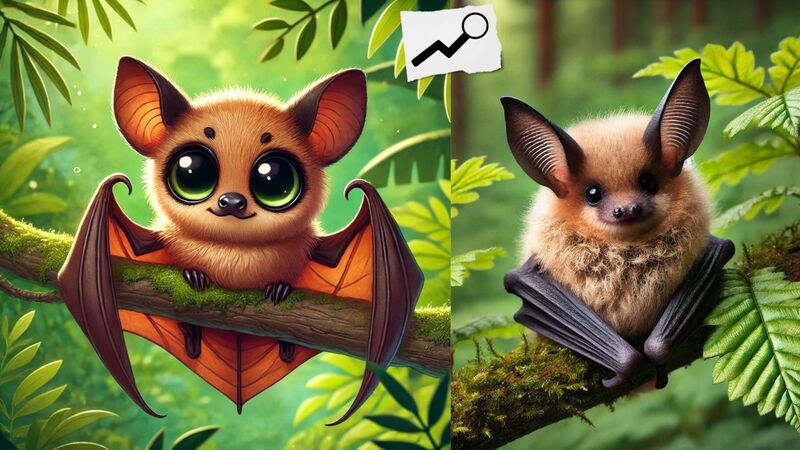Introduction
In the realm of wildlife, few creatures embody the blend of fascination and affection quite like the Cute:-_noi7qvbwi= bat. Often misjudged due to their nocturnal habits and eerie appearances, bats possess an undeniable cuteness that, once appreciated, reveals a softer side to these remarkable mammals. In this article, we’ll delve into the world of the cute bat, exploring its unique characteristics, its role in ecosystems, and why this often-overlooked animal deserves a place in our hearts.
The Natural Elegance of the Cute:-_noi7qvbwi= bat
Physical Characteristics
One cannot help but be charmed by the Cute:-_noi7qvbwi= bat delicate features. Unlike their sometimes frightening portrayals in popular media, these creatures boast a surprising array of endearing traits. With their small, round faces, large, expressive eyes, and soft fur, many bats present an image that could easily fit into the category of ‘cute.’ Their wings, while functional for flight, are often folded in a way that accentuates their tiny, adorable size. For instance, the bumblebee bat, one of the smallest bat species, has a wingspan of only about 5.7 inches, making it particularly easy to view as cute and miniature.
Behavioral Traits
Beyond their physical attributes, the behaviors of bats can also be endearing. Many species are social animals, often found in colonies that exhibit close-knit relationships and cooperative behaviors. The way they groom each other and huddle together for warmth highlights their affectionate nature. The sight of a group of these tiny creatures clinging to one another or playing in flight adds a layer of charm to their already cute demeanor.
The Cute:-_noi7qvbwi= bat Ecological Role
Insect Control
The Cute:-_noi7qvbwi= bat plays a crucial role in maintaining ecological balance, particularly through insect control. Many species of Cute:-_noi7qvbwi= bat are insectivores, meaning they primarily consume insects. This dietary habit helps keep insect populations in check, which can be particularly beneficial for agriculture and human habitation. By consuming vast quantities of insects, bats reduce the need for chemical pesticides, making them invaluable allies in promoting a healthier environment.
Pollination and Seed Dispersal
Apart from their role in controlling insect populations ,Cute:-_noi7qvbwi= bat are also vital pollinators and seed dispersers. Fruit-eating bats, in particular, contribute to the propagation of many plant species. As they feed on fruits, they inadvertently spread seeds through their droppings. This process aids in forest regeneration and the maintenance of diverse plant communities. For instance, the nectar-feeding bats in tropical regions are crucial for the pollination of various plants, including some species of cacti and bananas.
The Cute:-_noi7qvbwi= bat Relationship with Humans
Historical Perspectives
Historically, Cute:-_noi7qvbwi= bat have often been shrouded in myth and superstition, with many cultures viewing them as omens or symbols of the supernatural. However, there is also a rich history of reverence and appreciation for these animals. For example, in various indigenous cultures, bats are celebrated for their roles in nature and are sometimes featured in folklore and art.
Conservation Efforts
In recent times, there has been a growing recognition of the importance of Cute:-_noi7qvbwi= bat in ecosystems, leading to increased conservation efforts. The cute bat, despite its endearing qualities, faces numerous threats from habitat loss, climate change, and disease. Organizations around the world are working to protect bat habitats and promote understanding and appreciation for these fascinating creatures. Initiatives such as bat houses and conservation programs are crucial in ensuring the survival of bat populations.
Why the Cute:-_noi7qvbwi= bat Deserves Our Appreciation
The Appeal of the Cute Bat
The term Cute:-_noi7qvbwi= bat may seem like a contradiction to some, but this juxtaposition only adds to the creature’s allure. The bat’s small size, expressive features, and charming behaviors make it an animal that can easily win hearts. When people take the time to learn about bats and their vital roles in ecosystems, they often develop a newfound appreciation for these animals.
Promoting Awareness and Education
Education plays a critical role in changing perceptions about Cute:-_noi7qvbwi= bat By promoting awareness of the cute bat’s ecological importance and the threats it faces, we can foster a more positive image and encourage conservation efforts. Educational programs that highlight the bat’s role in insect control, pollination, and seed dispersal help underscore why it is essential to protect these animals and their habitats. Contact us for more details
visit our site.
Conclusion
In conclusion, the cute Cute:-_noi7qvbwi= bat is a creature that, despite its sometimes misunderstood appearance, offers a wealth of endearing qualities and significant ecological benefits. From its delicate physical features and charming behaviors to its vital roles in insect control, pollination, and seed dispersal, the cute bat proves to be a fascinating and lovable part of our natural world. As we continue to learn more about these remarkable animals, it becomes increasingly clear that they are deserving of our respect and protection. By appreciating the cute bat’s unique attributes and supporting conservation efforts, we can ensure that these delightful creatures continue to thrive in the wild.
.
